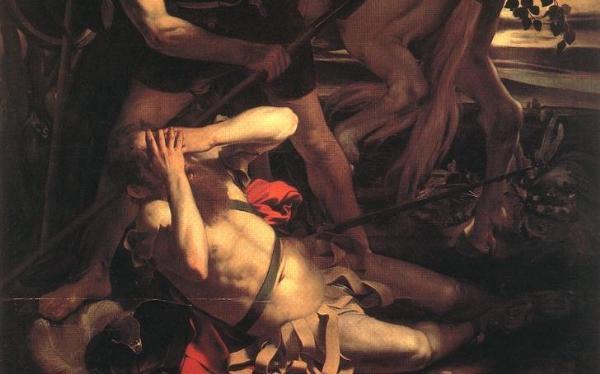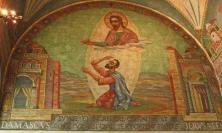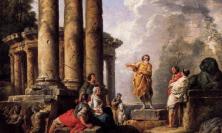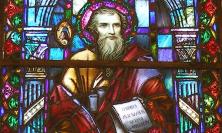
This Sunday – the Feast of Saints Peter and Paul – marks the start of a year dedicated to the memory of Saint Paul. But who was this man from Tarsus who influenced the course of Christianity more than probably any other saint? Peter Edmonds SJ introduces the ‘Thirteenth Apostle’ and his writings in the first of a special Thinking Faith series for this ‘Pauline Year’.
On 29th June last year, the Solemnity of Peter and Paul, Pope Benedict attended first vespers in the Basilica of St Paul in Rome. Towards the end of his homily, he suddenly announced that the following year would be a Jubilee Year dedicated to the memory of St Paul, the ‘first Christian theologian’. This ‘Jubilee Year’ would begin on 28th June 2008. The jubilee in question was the 2000th anniversary of the birth of Paul, said to have taken place between the year 7 AD and 10 AD.
This announcement of Pope Benedict came as a surprise, and a challenging surprise at that. Who was this Paul, we might ask, and what do we know about him? How well known is he to the average Catholic? The Pope recalls how Paul ‘fell to the ground dazzled by the divine light on the road to Damascus’ and was converted to Christ. This conversion experience has been immortalised by the artist Caravaggio who painted him thrown from his horse by the shock of a divine call. His name is heard in our liturgy most Sundays as the author of the letters regularly read out as a second reading. But few Catholics have had much instruction about Paul or have read through these letters as a whole. And as for that horse, it is never mentioned in the scriptural accounts of Paul’s conversion. Luke, in the Acts of the Apostles, tells the story of Paul’s conversion three times in increasingly dramatic detail, but he never includes the horse.
If we read through the New Testament, we first come across Paul in the Acts of the Apostles, which comes immediately after the gospels. As Luke’s story proceeds, it is increasingly dominated by Paul, and the book closes with Paul in prison in Rome, speaking without hindrance of the kingdom of God (Acts 28:31). We then find a block of twelve letters, all of which are attributed to Paul. In a typical modern translation, these vary in length from the 20 pages of the Letter to the Romans which comes first, to the single page of the Letter to Philemon which concludes the collection.
And therein lies a problem for the person who wants to know Paul. The Acts of the Apostles provides an attractive and dramatic account of Paul, but it is – the authorities tell us – the last account to be written. It is usually dated around 85 A.D., some thirty years later than Paul’s letters. Most thoughtful readers want to read the earliest material first, and whilst a gap of thirty years allows historical events to mature, it also risks losing the freshness of contemporary events and tensions. Problems which were grave at the time have cooled off years later. The fierce controversy of the Letter to the Galatians has turned into the gentle debate of the Jerusalem Council described in Acts 15.
The order of the letters in the New Testament constitutes another difficulty. Nine are written to communities and four to individuals. They are presented in the New Testament according to their length, so the person who reads them one after another has to put up with a strange chronology which makes it impossible to accompany Paul as he developed in his life and thought. Instead, it is helpful to approach these letters and the Acts of the Apostles in their probable order of composition rather than as we find them in the New Testament.
We begin with Paul’s first letter to the Thessalonians, commonly dated around the year 50 A.D., which gives it the distinction of being the first New Testament book to be written. And this makes ‘Paul’ the first word of the New Testament! As we read through the four pages of this letter, we realise that Paul’s first priority in his apostolate was the personal visit. If this was impossible, then he would send his delegate, in this case Timothy. Only as a third possibility would he write a letter. This was something new for him and a risk. To minimise the risk, he gave an order, the only one in this letter, that the letter be read out to the whole community (1 Thessalonians 5:27). The experiment must have been successful, because this became the first of a series of letters which were written over the next ten years. If we want information about Paul himself, we find it in the second chapter. He has suffered persecution in Philippi, has worked night and day so as not to burden the community, has behaved with sincerity and commitment in contrast to the charlatan travelling teachers with whom enemies were comparing him.
There is no certainty about the precise order of the letters. The next may have been the Letter to the Galatians. This reveals to us Paul on the defensive. He has been accused of offering his converts a watered down version of Christianity. Surely rivals argued, if God had expected the people of Israel to live by the precepts of the Mosaic law for a thousand years, how could Paul tell God’s people in Galatia to put them on one side? Paul argues with skill from his own story, from theological principles and from the ethical life. Giving his own story, Paul refers briefly to his conversion. He simply claims that God has revealed his son to him and that now it is not Paul who was living so much as Christ living in him (Galatians 1:12; 2:20).
We find two letters to the Corinthians in our New Testament. A careful reader will find references in their text to two more, so that he must have written at least four times to the Corinthians. We learn of his weakness, of the fear and trembling that was his lot when he first came to them (1 Corinthians 2:3). In the “fool’s speech” towards the end of 2 Corinthians, he lists, with reluctance, the hardships of the apostolic life (2 Corinthians 11:21-32). He was by this time convinced that only when he was weak could the power of Christ work in him.
The warmest of the letters is that to the Philippians. Again and again he refers to his friendship with that community. The best known part is the second chapter in which Paul writes eloquently of the ‘emptying’ of Christ. He accepted the cross, but ‘God exalted him and gave him the name that is above every name’ (Philippians 2:6-11). Paul saw in this emptying of Christ a model of what had happened in his own life. He had been blameless as far as righteousness under the law was concerned, but now he considered all this as rubbish, in order that he might gain Christ (Philippians 3:5-11).
The letters considered so far were written in response to pastoral situations. The letter to the Romans, the longest letter, the first in the New Testament collection, was written before a pastoral visit. Roman Christianity was most likely dominated by former Jews, many of whom were suspicious of Paul whose mission had been to the Gentile nations. They had bad memories of his activity as their persecutor in his younger days. So, in this letter, Paul lays out his theology, in particular his understanding of the relation between the Mosaic Law and Christ (Romans 3:21-26), and he concludes with a list of his friends and collaborators whom he hoped would vouch for him as one who was true to God’s grace (Romans 16:1-16).
These six letters of Paul are commonly described as the ‘undisputed’ Pauline letters because no serious scholar doubts their authenticity as being works of the apostle. To them we must add a seventh, the Letter to Philemon. Although it is only one page in length, it demonstrates Paul’s skill as a writer in making it extremely difficult for Philemon to refuse the request that he is making about his slave. Though the legal position of Onesimus may still be that of a slave, his real status before God was that of a beloved brother ‘both in the flesh and in the Lord’ (Philemon 16).
There is general agreement among experts that these ‘undisputed’ letters date from the 50s of the first century. There are three more letters to communities which make these experts hesitate about whether they were really written by Paul rather than by someone of the ‘Pauline school’. The longest of these, shorter than the letters to the Corinthians, Galatians and Romans, is the letter to the Ephesians. This is clearly from the world of Paul, but the fact that it goes beyond the Paul we have met so far has led to queries about its authorship. In Romans, Christians look forward to a share in the resurrection (Romans 6:5); in Ephesians, they are already sitting in heaven (Ephesians 2:6). In 1 Thessalonians (2:15), there are obvious distinctions between Jew and Gentile, but in Ephesians, the wall between them has been broken down (Ephesians 2:14). At best, Ephesians can be regarded as an introduction to the world of Pauline theology.
There are many parallels between the letter to the Ephesians and that to the Colossians. The balance of expert opinion is in favour of Pauline authorship, but the considerable minority denying it for similar reasons as for Ephesians, consign it to the group of ‘disputed letters’ of Paul. There is similar division about the authorship of 2 Thessalonians. Suffice to say that the spontaneity and originality of the Paul who writes in the first letter seem to be absent in this second.
The third group of Pauline letters is known as ‘The Pastorals’. Here Paul is presented as one close to death in prison, writing to two of his disciples, Timothy and Titus, who are about to take pastoral responsibility for churches in Crete and elsewhere. It is a time of transition when Christians require competent leaders and sound doctrine; the first generation of apostles and evangelists has passed on. Whoever wrote the final form of these letters may well have included quotes from the genuine Paul, the one who had fought the good fight, run the race, kept the faith (2 Timothy 4:7), but was adapting his spirit and teaching to times after his death as a martyr under Nero in the 60s.
The fullest and most enduring picture of Paul comes from the Acts of the Apostles. Here he is portrayed like Jesus himself. Like Jesus, he speaks to a Jewish audience in a synagogue (Acts 13:14; Luke 4:16). He performs miracles of healing (Acts 14:10; Luke 5:23). He is condemned by the leaders of his people (Acts 22:30; Luke 22:71). He is brought before the Roman authorities (Acts 22:6; Luke 23:1). All that remains is his death which, for some reason, Luke omits to describe. But Luke’s account does not do justice to the depth of Paul’s personality and thought that emerges in the undisputed letters. His achievement is to leave the reader with a dramatic picture of Paul as a hero of the Christian mission.
Pope Benedict in his announcement of the Pauline jubilee looked forward to liturgical, cultural and ecumenical events to mark this jubilee, as well as various pastoral and social initiatives. This presupposes a desire and willingness to get to know the Paul whom we meet in the pages of the New Testament, especially in his ‘undisputed letters’. Catholics, on the whole, are not very good on Paul. Ours is a biblical spirituality nourished chiefly by the gospels, which usually form the staple of the Sunday homily. Few preachers offer a systematic exposition of the second readings which on most Sundays come from a Pauline letter. Paul is not really given much of a chance in the Sunday liturgy. Protestants generally make much more of him, so much so that some Catholics have a suspicion that he was really a Protestant! Certainly Luther made frequent appeal to him in his reformation controversies.
Paul is mentioned once more in the New Testament in what is usually considered to be its last book to be written, the Second Letter of Peter. As it approaches its end, its writer warns,
So also our brother Paul wrote to you according to the wisdom given him, speaking of this as he does in all his letters. There are some things in them difficult to understand, which the ignorant and the unstable twist to their own destruction, as they do the other scriptures. (2 Peter 3:15-16)
In this Pauline year, we are encouraged to fight our own ignorance and instability by making an effort to appreciate God’s gift to his Church of the Apostle Paul. Let us also pick up the ecumenical challenge in all this, which Pope Benedict referred to as he closed his homily:
The Apostle to the Gentiles, who was especially committed to taking the Good News to all peoples, left no stone unturned for unity and harmony between all Christians.
Peter Edmonds SJ is tutor in Biblical Studies at Campion Hall, Oxford.
Read more of Thinking Faith’s series on Saint Paul:
![]() The Long Road to Damascus – Bishop John Arnold
The Long Road to Damascus – Bishop John Arnold
![]() Paul the Pastor – Jerome Murphy-O’Connor OP
Paul the Pastor – Jerome Murphy-O’Connor OP
![]() The Vision of Saint Paul – Nick King SJ
The Vision of Saint Paul – Nick King SJ
![]() Getting to know Saint Paul today – David Neuhaus SJ
Getting to know Saint Paul today – David Neuhaus SJ
![]() Paul, Trinity and Community – Michael Mullins
Paul, Trinity and Community – Michael Mullins
![]() Power in Paul – David Harold-Barry SJ
Power in Paul – David Harold-Barry SJ
![]() St Paul and Ecumenism – Bishop John Arnold
St Paul and Ecumenism – Bishop John Arnold
![]() The Letter of Paul to the Philippians – Peter Edmonds SJ
The Letter of Paul to the Philippians – Peter Edmonds SJ
![]() Thinking about Christ?s Resurrection in the Year of St Paul – Gerald O?Collins SJ
Thinking about Christ?s Resurrection in the Year of St Paul – Gerald O?Collins SJ
![]() The Letter to the Colossians: Jesus and the Universe – Brian Purfield
The Letter to the Colossians: Jesus and the Universe – Brian Purfield





